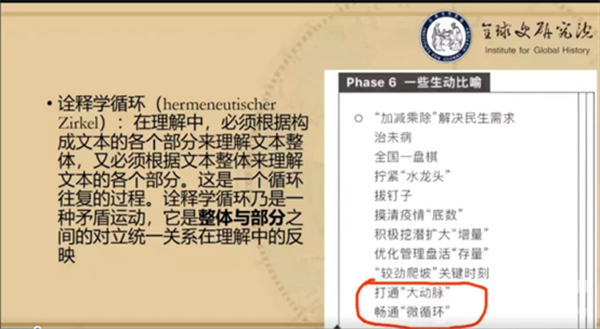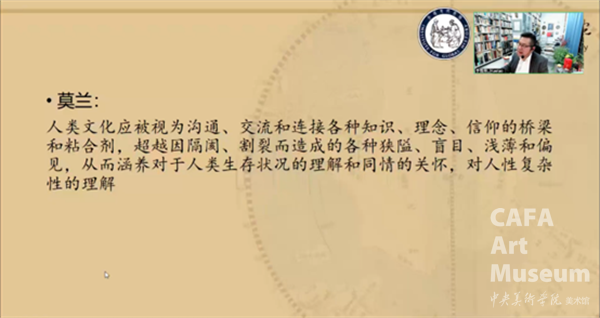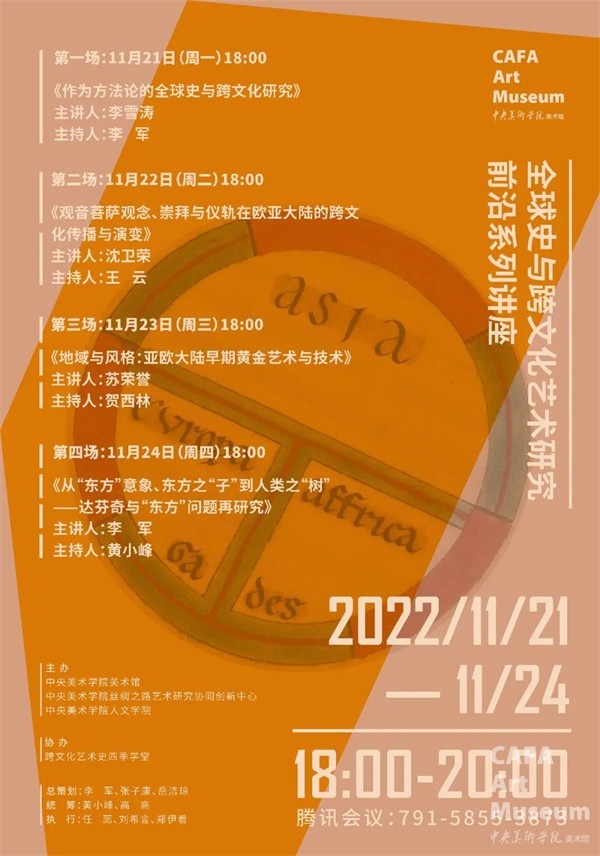

由中央美术学院美术馆、中央美术学院丝绸之路艺术研究协同创新中心、中央美术学院人文学院联合主办的“全球史与跨文化艺术研究前沿系列讲座”于2022年11月21日拉开序幕,北京外国语大学历史学院院长/全球史研究院院长李雪涛教授首讲,讲座主题为“作为方法论的全球史与跨文化研究”,讲座主持为中央美术学院人文学院院长李军教授。本次讲座还得到了“跨文化艺术史四季学堂”的支持。
讲座综述

本次讲座围绕 “作为方法论的全球史与跨文化研究”展开,在研究方法上突破了过去常用的比较研究法:从整体和互动的视角出发,结合具体案例,为文化互化现象和创造新文化的现象提供了前瞻性的方法论指导。讲座伊始,李雪涛教授以黄仁宇(1918-2000)的《万历十五年》开篇,介绍了万历十五年(公元1587年)同年发生的东西方历史事件:西班牙舰队征英事件以及国内朝廷的一系列事件,他从黄仁宇提供的这样一种历史横截面得出初步结论:看似偶然发生的小事正是后面发生大事的症结所在。历史维度的纵轴和空间维度的横轴完全可以推导出一部全球史。而黄仁宇著作的中英德三语版本则体现了跨文化性,这些都为全球史和跨文化研究者带来重要启示。

随后,李雪涛教授介绍了全球史与跨文化研究的哲学基础——诠释学(hermeneutics)与代表学者伽达默尔(Hans-Georg Gadamer, 1900-2002)。他认为,伽达默尔最重要的一本书《真理与方法》(Wahrheit und Methode, 1960)是当代学术的基础,全书要处理的问题就是“理解”(Understanding/Verstehen)的问题,而理解的不确定性正是当代学术的最重要特征。因而可以推演出思想不是本质主义的,按照伽达默尔的说法,诠释是一个过程,不存在最终的文本,阐释具有历史性(Geschichtlichkeit)。如果没有伽达默尔的诠释学,就无法确立全球史的基本观念和跨文化研究的基本理论。伽达默尔的诠释学循环有两条路径:一是通过文本的各部分理解整体,二是通过整体理解各部分。整体和部分具有对立统一的关系。

接下来,李雪涛教授谈到全球史的基本理念,首先给出全球史的定义:全球史是一种历史研究和历史书写的新视角、新方法,从整体观和联系观来编撰宏观历史或考察微观个案,或者以超越民族国家的视野来看待一些跨国历史现象,是当代全球化背景下历史学“全球转向”的产物。这种联系的观点是受到了1963年威廉·麦克尼尔(William Hardy McNeill, 1917-2016)的《西方的兴起:人类的共同体史》(The Rise of the West: A History of the Human Community)一书的影响,20世纪80年代以后这种全球史的方法就被大多数人所采用。此外全球史还可以是研究领域和研究方法,如茶叶、鸦片、战争等历史很难被限定在某个民族或国家的范围内进行研究。世界历史(Weltgeschichte)这个概念首先是从歌德(Johann Wolfgang von Goethe, 1749-1832)创立的“世界文学”(Weltliteratur)的概念来的,之后雅斯贝尔斯(Karl Jaspers, 1883-1969)创立了“世界哲学”(Weltphilosophie)的概念,这种哲学不是叠加后的产物,而是具有世界关联性的哲学,跟全球史一样研究相互间的关系和联系。中国的世界史学者吴于廑(1913-1993)先生正是对人类历史从原始、孤立分散的人群发展为全世界成为一个密切联系整体的过程也进行过系统的阐述。

随后,李雪涛教授介绍了两套研究理论:首先是16世纪大航海时代以前用雅斯贝尔斯的“轴心时代”(Achsenzeit)方法将人类历史的起源看作是同时实现的“突破”(Durchbruch),而后是大航海时代以后的历史时期,用以色列学家埃森施达特(Shmuel Noah Eisenstadt, 1923-2010)的“多元现代性理论”(Multiple modernities theory)。他还介绍了希腊裔历史学家斯塔夫里阿诺斯(Leften Stavros Stavrianos, 1913-2004)的《全球通史》,其中提出全球性探索的方法是现代历史编纂学的一个崭新的起点,而且很多学者也将其视为方法论的标杆。

接下来,李雪涛教授为大家介绍了全球史研究的重要概念。第一个概念是互动观,代表学者是威廉·麦克尼尔,他认为与外来者的交往是社会变革的主要推动力,这种动力推动着欧亚共生圈的形成和发展,直至囊括全球。比如美国历史学家、汉学家费正清(John King Fairbank, 1907-1991)也有著名的“冲击回应说”,他认为中国儒家思想所构建起的一整套官僚系统,如果没有鸦片战争的外来的推动力,也很难会有来自内部的改变的。后面李雪涛教授分别以小提琴和洗发剂(Shampoo)为例讲述物质文化背后的跨文化渊源。首先,小提琴虽然被视为西洋乐器,但它的各组成部分,尤其是琴身可以追溯到公元前15世纪上埃及古城的Theben墓室壁画,琴身可参考10世纪德国《圣经》插图中的大卫王竖琴和犍陀罗浮雕的弹琵琶者,同时还提到韩熙载《夜宴图》中琵琶与小提琴琴声的相似性。小提琴的弓可追溯到公元八世纪新疆于阗以及阿富汗的萨拉吉(Sarangi),经过欧亚大陆的跨文化交流最后在14世纪欧洲发明了小提琴。其次,洗发剂是英国在殖民印度时认识到高种姓印度人的卫生习惯之后,才开始进入到西方人的生活之中,成为西方现代文明的一部分。
此外,李雪涛教授呼吁研究者要反对任何先入为主的观念,同时也要反对任何形式的中心主义。反对任何形式的中心主义是全球史研究的第二个概念。要想超越欧洲中心主义德国哲学家黑格尔(G. W. F. Hegel, 1770-1831)的辩证法的正反合三一式(Triade)是一种很好的方法。


紧接着,李雪涛教授谈到了第三个方面:整体观。他介绍了美国历史学家马内拉(Erez Manela)《威尔逊瞬间》一书体现出来的有关1919年的整体史观:中国的“五四”运动与同年出现的多国的政治运动之关联。也就是说将研究置于全球史的视域下会找到事件之间各种各样的关联性。如果每个民族国家仅仅孤立地独自做研究的话,它可能只是一个谱系性的内部研究,只有同时把它放在一个全球的语境下来看待才可以是一个整体研究。


随后,李雪涛教授介绍了跨学科的研究方法。他讲到2013年跟德国国家科学院举办的会议“从地球仪到全球化”(Vom Globus zur Globalisierung)。与会学者的学术背景十分多元,因而说明全球史的研究有赖于多学科的助力和跨学科的视野。

在第四部分,李雪涛教授谈到了对比较方法的超越。其中提出了掌握外语的重要性,不会外语就不会反思自己母语,只有在比较之中我们才能够认识到自身的特点。

后面,李雪涛教授分别从优点和问题两方面入手分析比较方法。对于优点,教授分别分析了古代已知世界的观点、历史社会学观点、历史学家的比较、大问题意识和比较方法的优势五个方面。对于存在的问题,他着重分析了研究对象的内部差异,以及比较研究存在的共同尺度对研究结果的影响,而且认为问题的症结是内部因素所产生的社会变迁,而非互动和交流的结果。

在提出问题的基础上,李雪涛教授给出了纠正方案,分别是知识迁移史、纠缠史和关联史。随后,他谈到跨文化性与文化互化的问题。“跨文化性”(Transkulturalität)是由德国哲学家威尔士(Wolfgang Welsch, 1946-)提出的概念,威尔士认为我们的社会是一个异质和混合的社会,将外来的东西和自己的东西相互交错和融合,形成动态实体。由于历史或文化变化而处于不断的变化之中,这个就是跨文化。

就此,李雪涛教授以冯友兰在《中国哲学简史》(A Short History of Chinese Philosophy, 1948)中提出的“佛教在中国”(Buddhism in China)以及“中国佛教”(Chinese Buddhism)两个概念为例,具体说明了佛教传入中国以后接受本土化改造的过程为解读印度性和中国性提供了重要的途径,构成了两种文明共同问题的关键媒介,两种文化的历史资源得以进入互为批判的动态关系之中。随后教授谈到文化互化的概念,以辣味炖汤(阿西亚科)和沙拉比喻文化的融合和交汇现象。

接下来,李雪涛教授分别以牧溪的《六柿图》、伍重(Jørn Utzon,1918-2008)的创造为例分析文化互化的现象。
20世纪,南宋牧溪《六柿图》传入西方世界之后引起轰动,汉学家阿瑟·韦利(Arthur Waley, 1889-1966)称《六柿图》为“激情……凝结成惊人的平静”,并被认为是东方艺术的精华。海德堡大学艺术史教授谢凯(Dietrich Seckel, 1910-2007)专门讨论过《六柿图》,而波恩大学教授顾彬(Wolfgang Kubin, 1946-)认为《六柿图》是整体存在的一个完美表达(海德格尔意义上的整体存在:das gesamte Sein)。而日本在室町时代从《六柿图》中发展出“涩味”的概念,后期转化为一种令人愉悦的美学形态,即侘寂美学,一个器物能给人带来内心的宁静和精神上的向往。1960年美国杂志《美丽的住房》(House Beautiful)专门介绍了作为日本美学概念的“涩味”,造成了对当时流行的“美国生活方式”(the American way of life)的冲击。此外,李雪涛教授还以美国历史学家怀特(Lynn White Jr., 1907-1987)评铃木出版的《禅宗文论集》作为案例,将翻译视为语言媒介上的跨文化性。

第二个例子讲的是20世纪最重要的建筑师之一,丹麦建筑师伍重建造了被评为世界文化遗产的悉尼歌剧院,还提到了另一位建筑史家艾术华(Johannes Prip-Møller, 1889-1943)在中国研究佛教寺院建筑,考察寺院生活,将收集到的资料进行整理, 并于1937年出版《中原佛寺图考》,书中还保留了包括李鸿章牌位在内的珍贵图片。而伍重正是在丹麦国家图书馆看到梁思成(1901-1972)送给艾术华的中国建筑模型,由此生发了对中国建筑的兴趣。而他收藏的《营造法式》的书籍对他设计悉尼歌剧院有着十分重要的影响。伍重收藏的艾术华的《中原佛寺图考》一书有一页提供了安徽九华山祗园寺的山门照片,伍重在其基础之上混合成为一个新建筑,在丹麦哥本哈根建造了巴格斯韦德教堂(Bagsværd Church)——这座教堂是丹麦国教会的教堂,被认为是现代教堂建筑的杰作,而教堂的侧面保留了徽派建筑的山墙。

最后李雪涛教授以法国哲学家莫兰(Edgar Morin, 1921-)的思想作结,莫兰认为传统的科学方法是分离的、肢解的和箱格化的,也就是说都是分隔开来的。在无限细分的微观研究下,还原的后果之一是掩盖了整体、复杂、实体的多维度性,部分和整体之间互动和反馈的关系,因而失去了对复杂问题的总体性和根本性认识。因而要打破自牛顿时代建立的教条,建立分析为主、还原论、线性因果关系决定论等的传统的“科学方法”,进入一种跨学科的、多维度的、跨国界的、总体性的和全球化的思维范式中。而艺术史所有研究的目标就是达到对人性复杂性的理解。


在讲座结束后的讨论部分,李军教授首先点出了李雪涛教授对“全球史与跨文化艺术研究系列讲座”的开端性意义,并从多个角度补充了跨文化研究的方法:一则,以人类的起源和智人的发展为例提出人类文明发源之初就是全球流动的;二则,以小见大,从单位门口的门禁系统延伸至国家间的边防和海关系统,因而推导出“门前自有路,边防属于后设的”结论。他进而援引加达默尔的阐释学,认为历史事件的意义需要每个人的重新解释。只要阐释的行为主体还在,事件的意义就没有完成,因而像柏林墙像中国长城都是后来建的,不是原来就有的。除了阐释学上的不确定性,还有宇宙自身的规律,即跨文化性,正是文明本身能够存在的前提。在此,李军教授以人的生命、呼吸系统、光合作用和能量,甚至是中国人“生意”的概念为例指出交换、吐纳和呼吸是渗透在人类生命中的,而全球史和跨文化史正体现了返本归原的观念和意识。后面,他还以法国的香水、英国的下午茶、中国的民乐唢呐、印度的“风油精”四个例子再次回应了所谓民族性正如国界一样是后设的,而跨文化性才是文明的本质。最后,李军教授以印度洋季风的季节性循环为例,提出这种跨文化的商业、物质文化交往具有一定的自然基础。
随后李雪涛教授也对跨文化的相关理论做了一些补充。他说前面提到的交换,可以联系到雅斯贝尔斯的交往理论,“communication”(Kumunikation)是人类交往最重要的一个基础。而且伽达默尔的阐释学明显超越了利玛窦在《天主实义》里的前现代学术认识,使得现当代的学术研究能够被定义为不确定性。另一位参与讲座的嘉宾澳门大学人文学院历史系杨斌教授提出当代全球史学者尤其需要关注的几点:首先,比较研究的方法具有局限性,不能体现含化或互化的过程,而从两种文化中创造一种新文化是最关键的历史事实和现象。其次,全球史研究确实是有重心的,但一定要保持对某种主义的警觉和反思,全球史能在西方兴起正是由于那些学者能对西方中心主义所持有的偏见进行反思。最后,他也提醒广大青年学者要有意识地加强外语学习,掌握外语是全球研究的基础性工作。
综述整理:谢涛

全球史与跨文化艺术研究前沿系列讲座
主办:中央美术学院美术馆、中央美术学院丝绸之路艺术研究协同创新中心、中央美术学院人文学院
协办:跨文化艺术史四季学堂
时间:2022年11月21日-11月24日
总策划:李军、张子康、岳洁琼
统筹:黄小峰、高高
执行:任蕊、刘希言、郑伊看
